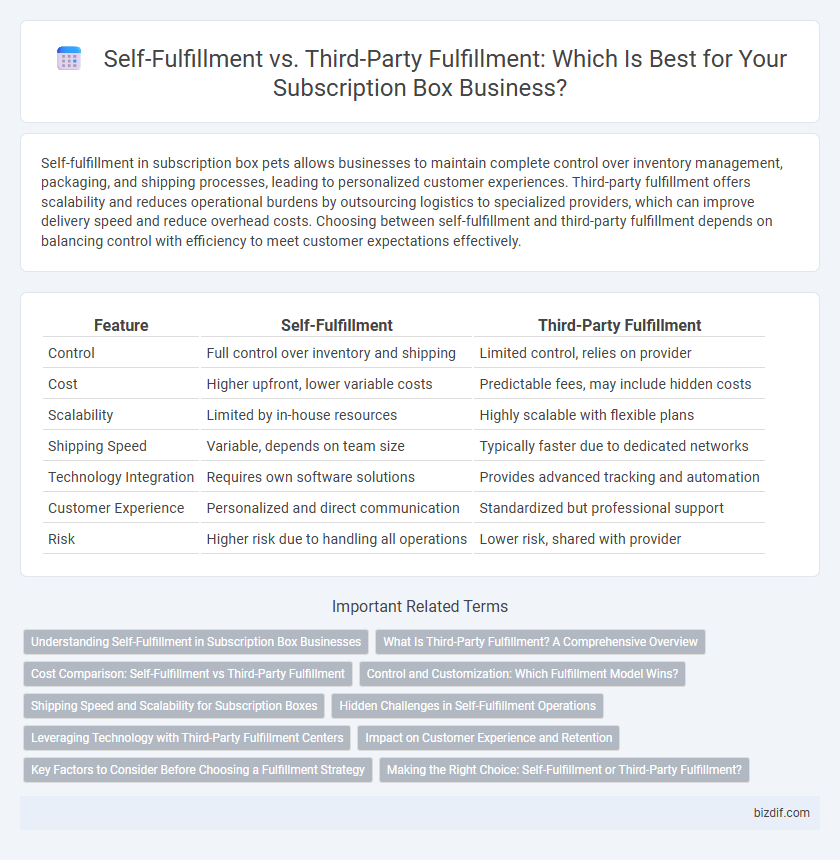Self-fulfillment in subscription box pets allows businesses to maintain complete control over inventory management, packaging, and shipping processes, leading to personalized customer experiences. Third-party fulfillment offers scalability and reduces operational burdens by outsourcing logistics to specialized providers, which can improve delivery speed and reduce overhead costs. Choosing between self-fulfillment and third-party fulfillment depends on balancing control with efficiency to meet customer expectations effectively.
Table of Comparison
| Feature | Self-Fulfillment | Third-Party Fulfillment |
|---|---|---|
| Control | Full control over inventory and shipping | Limited control, relies on provider |
| Cost | Higher upfront, lower variable costs | Predictable fees, may include hidden costs |
| Scalability | Limited by in-house resources | Highly scalable with flexible plans |
| Shipping Speed | Variable, depends on team size | Typically faster due to dedicated networks |
| Technology Integration | Requires own software solutions | Provides advanced tracking and automation |
| Customer Experience | Personalized and direct communication | Standardized but professional support |
| Risk | Higher risk due to handling all operations | Lower risk, shared with provider |
Understanding Self-Fulfillment in Subscription Box Businesses
Self-fulfillment in subscription box businesses involves managing inventory, packing, and shipping orders internally, allowing for greater control over quality and customer experience. Companies retain direct oversight of the fulfillment process, which can lead to faster response times and personalized packaging options. This approach requires investment in warehousing space, staff, and shipping logistics to efficiently handle order volume.
What Is Third-Party Fulfillment? A Comprehensive Overview
Third-party fulfillment involves outsourcing inventory storage, packaging, and shipping to specialized logistics providers, enabling subscription box companies to streamline operations and reduce overhead costs. This service offers scalability, professional handling, and integration with e-commerce platforms, ensuring timely and accurate delivery to subscribers. Businesses benefit from third-party fulfillment by focusing on marketing and product curation while leveraging expert supply chain management.
Cost Comparison: Self-Fulfillment vs Third-Party Fulfillment
Self-fulfillment reduces direct expenses by eliminating third-party fees, yet involves higher labor costs and requires significant investment in warehousing and shipping infrastructure. Third-party fulfillment services charge fees that cover storage, packaging, and shipping, typically resulting in variable costs based on order volume and complexity. Businesses must analyze order frequency, scale, and operational capabilities to determine whether cost savings in self-fulfillment outweigh the convenience and scalability of third-party providers.
Control and Customization: Which Fulfillment Model Wins?
Self-fulfillment grants subscription box businesses complete control over inventory management, packaging, and shipping processes, enabling highly customized branding and personalized customer experiences. Third-party fulfillment services offer scalability and operational efficiency but often limit customization options and direct oversight. For brands prioritizing control and bespoke presentation, self-fulfillment typically emerges as the superior model.
Shipping Speed and Scalability for Subscription Boxes
Self-fulfillment in subscription boxes offers direct control over shipping speed, allowing businesses to customize delivery timelines and respond quickly to customer demands. Third-party fulfillment services leverage advanced logistics networks to scale operations rapidly, handling large volumes while maintaining consistent shipping speeds across regions. Balancing self-fulfillment's personalized agility with third-party scalability ensures optimal customer experience and growth potential in subscription box delivery.
Hidden Challenges in Self-Fulfillment Operations
Self-fulfillment in subscription box operations often faces hidden challenges such as inventory mismanagement, increased labor costs, and delayed shipping times that impact customer satisfaction. Businesses must handle packaging, quality control, and order accuracy internally, which requires significant resources and expertise. These operational complexities can lead to scalability issues and hidden expenses that third-party fulfillment centers typically mitigate through streamlined processes and established logistics networks.
Leveraging Technology with Third-Party Fulfillment Centers
Third-party fulfillment centers leverage advanced technology such as automated sorting systems, real-time inventory tracking, and API integrations to streamline subscription box operations and enhance accuracy. These technological capabilities reduce order processing time and improve customer satisfaction through faster shipping and seamless updates. Utilizing third-party fulfillment technology empowers subscription box companies to scale efficiently without investing heavily in their own warehouse infrastructure.
Impact on Customer Experience and Retention
Self-fulfillment in subscription boxes offers direct control over packaging, shipping speed, and quality, enhancing personalized customer experiences that boost retention rates. Third-party fulfillment can streamline operations and scale efficiently but may risk inconsistent service or delayed deliveries, potentially impacting customer satisfaction negatively. Consistent order accuracy and timely shipments are critical factors influencing subscriber loyalty and long-term business growth.
Key Factors to Consider Before Choosing a Fulfillment Strategy
Key factors to consider before choosing a fulfillment strategy for subscription boxes include cost efficiency, control over inventory, and scalability. Self-fulfillment provides direct oversight and personalized packaging options but requires significant time and resources, while third-party fulfillment offers expertise, reduced operational burden, and faster shipping but may limit customization. Evaluating order volume, budget constraints, and customer experience goals is essential to determine the optimal fulfillment approach.
Making the Right Choice: Self-Fulfillment or Third-Party Fulfillment?
Selecting between self-fulfillment and third-party fulfillment critically impacts subscription box business efficiency, costs, and customer satisfaction. Self-fulfillment offers greater control over inventory and shipping times but requires significant investment in warehousing and labor resources. Third-party fulfillment services provide scalable logistics, reduced operational workload, and access to advanced shipping technologies, making them ideal for growing subscription box companies seeking to optimize delivery speed and reduce overhead.
Self-fulfillment vs third-party fulfillment Infographic

 bizdif.com
bizdif.com